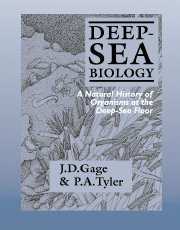Book contents
- Frontmatter
- Contents
- Preface
- Acknowledgements
- PART I The development of deep-sea biology, the physical environment and methods of study
- 1 Historical aspects
- 2 The physical environment of the deep sea
- 3 Methods of study of the organisms of the deep-sea floor
- PART II Organisms of the deep-sea benthic boundary
- PART III Patterns in space
- PART IV Processes: patterns in time
- PART V Parallel systems and anthropogenic effects
- References
- Species index
- Subject index
1 - Historical aspects
Published online by Cambridge University Press: 05 June 2012
- Frontmatter
- Contents
- Preface
- Acknowledgements
- PART I The development of deep-sea biology, the physical environment and methods of study
- 1 Historical aspects
- 2 The physical environment of the deep sea
- 3 Methods of study of the organisms of the deep-sea floor
- PART II Organisms of the deep-sea benthic boundary
- PART III Patterns in space
- PART IV Processes: patterns in time
- PART V Parallel systems and anthropogenic effects
- References
- Species index
- Subject index
Summary
The history of the study of the populations inhabiting the interface of the floor of the deep ocean with the overlying water spans a short period of little more than the maximum lifespan of a blue whale (approx. 120 yr). We associate this with the remoteness of the deep sea and the resulting difficulties in studying this environment: our methods of study are inhibited by the need for our instrumentation and observation chambers to be encapsulated in the atmosphere of the surface, and strengthened against the crushing pressure of a water column several kilometres in height.
EARLY EXPLORATION OF THE FAUNA OF THE DEEP-SEA FLOOR
In the middle years of the nineteenth century, in his investigations by dredging for life on the bottom of the deep fjords of the west coast of his country, the Norwegian pastor/naturalist, Michael Sars, together with his son, G. O. Sars, had listed nearly 100 species of invertebrate living at depths greater than 600 m. Even earlier, in 1818, the British explorer John Ross made a fortuitous discovery of a many-armed basket star (Fig. 1.1) from a sounding line cast in a depth of more than 1.6 km during his search for the North West Passage. Later, James Clark Ross and J. Hooker on the exploratory voyages of the ‘Erebus’ and ‘Terror’ to the southern ocean in 1839–43 had obtained animals from the mud on the sounding lead in a depth of 1.8 km and described a ‘teeming animal life’ on the Antarctic continental slope.
- Type
- Chapter
- Information
- Deep-Sea BiologyA Natural History of Organisms at the Deep-Sea Floor, pp. 3 - 8Publisher: Cambridge University PressPrint publication year: 1991

